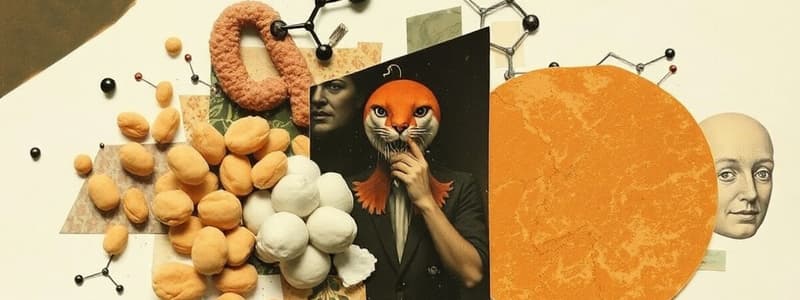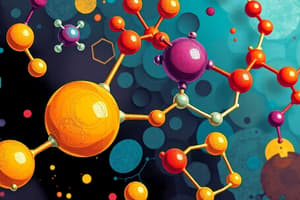Podcast
Questions and Answers
What type of bond links the glucose units in α-amylose?
What type of bond links the glucose units in α-amylose?
- α(1-4) glycosidic bonds (correct)
- β(1-4) glycosidic bonds
- α(1-6) glycosidic bonds
- γ(1-4) glycosidic bonds
Which enzyme cleaves single maltose units from the non-reducing end of the starch polymer?
Which enzyme cleaves single maltose units from the non-reducing end of the starch polymer?
- α-Amylase
- α(1-6) glucosidase
- Glycogen synthase
- β-Amylase (correct)
What is the final product resulting from the complete hydrolysis of starch by amylases?
What is the final product resulting from the complete hydrolysis of starch by amylases?
- Dextrins
- Maltose
- Glucose
- Limit Dextrin (correct)
What structural characteristic distinguishes amylopectin from α-amylose?
What structural characteristic distinguishes amylopectin from α-amylose?
Why can humans not digest cellulose?
Why can humans not digest cellulose?
What type of carbohydrate is cellulose regarded as?
What type of carbohydrate is cellulose regarded as?
What is the function of α-amylase in digestion?
What is the function of α-amylase in digestion?
Which component in plant cells is primarily made of cellulose?
Which component in plant cells is primarily made of cellulose?
What type of bond connects monosaccharides to form disaccharides and polysaccharides?
What type of bond connects monosaccharides to form disaccharides and polysaccharides?
Which of the following carbohydrates is classified as a polysaccharide?
Which of the following carbohydrates is classified as a polysaccharide?
What is the primary function of carbohydrates in living organisms?
What is the primary function of carbohydrates in living organisms?
Which of the following is not a type of carbohydrate?
Which of the following is not a type of carbohydrate?
Which type of carbohydrate is known for its structural role in plant cell walls?
Which type of carbohydrate is known for its structural role in plant cell walls?
What process occurs when a glycosidic bond forms between monosaccharides?
What process occurs when a glycosidic bond forms between monosaccharides?
Which of these carbohydrates is primarily used for energy storage in animals?
Which of these carbohydrates is primarily used for energy storage in animals?
Which carbohydrate is a major component of the exoskeletons in arthropods?
Which carbohydrate is a major component of the exoskeletons in arthropods?
What ratio do carbohydrates typically have of carbon, hydrogen, to oxygen?
What ratio do carbohydrates typically have of carbon, hydrogen, to oxygen?
Which of the following is NOT a function of carbohydrates?
Which of the following is NOT a function of carbohydrates?
Which type of carbohydrate is most commonly used as a storage form in animals?
Which type of carbohydrate is most commonly used as a storage form in animals?
Which of the following is a disaccharide?
Which of the following is a disaccharide?
What is the primary role of cellulose in plants?
What is the primary role of cellulose in plants?
Lactose is composed of which two monosaccharides?
Lactose is composed of which two monosaccharides?
Under what condition is lactose intolerance most likely to occur?
Under what condition is lactose intolerance most likely to occur?
Which of the following carbohydrates provides energy primarily for cellular activities?
Which of the following carbohydrates provides energy primarily for cellular activities?
Which polysaccharide is responsible for energy storage in plants?
Which polysaccharide is responsible for energy storage in plants?
Glycogen differs from starch primarily in its:
Glycogen differs from starch primarily in its:
Glucose serves as a key metabolic fuel because it is:
Glucose serves as a key metabolic fuel because it is:
What type of carbohydrate is characterized as many sugar units joined together?
What type of carbohydrate is characterized as many sugar units joined together?
Which characteristic is unique to chitin compared to other carbohydrates?
Which characteristic is unique to chitin compared to other carbohydrates?
Flashcards
Organelles
Organelles
Structures within a cell that perform specific functions.
Ecosystem
Ecosystem
A community of living organisms and their physical environment.
Biosphere
Biosphere
All the living organisms on Earth and the places they live.
Macromolecule
Macromolecule
Signup and view all the flashcards
Molecule
Molecule
Signup and view all the flashcards
Biomolecules
Biomolecules
Signup and view all the flashcards
Carbohydrate
Carbohydrate
Signup and view all the flashcards
Monosaccharide
Monosaccharide
Signup and view all the flashcards
Disaccharide
Disaccharide
Signup and view all the flashcards
Polysaccharide
Polysaccharide
Signup and view all the flashcards
Glucose
Glucose
Signup and view all the flashcards
Glycosidic bond
Glycosidic bond
Signup and view all the flashcards
Starch
Starch
Signup and view all the flashcards
Amylose structure
Amylose structure
Signup and view all the flashcards
Amylopectin structure
Amylopectin structure
Signup and view all the flashcards
α-amylase function
α-amylase function
Signup and view all the flashcards
β-amylase function
β-amylase function
Signup and view all the flashcards
Limit dextrin
Limit dextrin
Signup and view all the flashcards
Cellulose structure
Cellulose structure
Signup and view all the flashcards
Hydrolysis of Starch
Hydrolysis of Starch
Signup and view all the flashcards
Debranching Enzyme
Debranching Enzyme
Signup and view all the flashcards
What are the four main elements found in living organisms?
What are the four main elements found in living organisms?
Signup and view all the flashcards
What are the four main classes of organic compounds?
What are the four main classes of organic compounds?
Signup and view all the flashcards
What are the building blocks of carbohydrates?
What are the building blocks of carbohydrates?
Signup and view all the flashcards
What is a glycosidic bond?
What is a glycosidic bond?
Signup and view all the flashcards
What is a polysaccharide?
What is a polysaccharide?
Signup and view all the flashcards
What is the biological function of cellulose?
What is the biological function of cellulose?
Signup and view all the flashcards
What is the biological function of starch?
What is the biological function of starch?
Signup and view all the flashcards
What are glycosylated compounds?
What are glycosylated compounds?
Signup and view all the flashcards
Study Notes
Fundamentals of Human Biology - Carbohydrates
- Carbohydrates are composed of carbon, hydrogen, and oxygen in a 1:2:1 ratio.
- Carbohydrates are also called hydrates of carbon, reflecting the 2:1 ratio of hydrogen to oxygen (H₂O).
- Carbohydrates include: sugars, starches, glycogen, cellulose, and chitin.
- Sugars and starches are energy sources for cells.
- Cellulose and chitin are structural components.
- Carbohydrates are made of sugar units – saccharides (monosaccharides, disaccharides, polysaccharides).
Learning Outcomes
- The presentation will introduce the four main elements of biological importance.
- It will describe the main classes of organic compounds (carbohydrates, proteins, lipids, and nucleic acids).
- It will discuss the structure of monosaccharides and the glycosidic bond.
- It will explain polysaccharide structure and examples like cellulose, starch, and chitin.
- It will discuss the role of carbohydrates in glycosylated compounds.
Biological Molecules
- FUNBIO.1 - Carbohydrates
- FUNBIO.2 - Proteins
- FUNBIO.3 - Lipids and Nucleic Acids
Organization of Living Matter
- Organisms consist of organ systems, which are made up of organs, tissues, and cells.
- Atoms combine to form molecules, which organize into organelles.
- Chemical levels include atoms, molecules, and macromolecules.
- The diagram illustrates organizational levels from molecules to ecosystems.
Biomolecules
- Biomolecules consist of organic compounds, which include carbon, hydrogen, oxygen, and nitrogen.
- Inorganic compounds include oxygen (O₂), carbon dioxide (CO₂), water (H₂O), inorganic acids, bases, and salts.
- Carbohydrates, proteins, lipids, and nucleic acids are the major classes of organic compounds in biomolecules.
Why are these compounds so important?
- These compounds help build cells and tissues.
- They take part in and regulate metabolic processes.
- They transmit information and provide energy for life.
Types of Carbohydrates
- Sugars are an energy source for cells.
- Starches and cellulose/chitin are structural components.
- Carbohydrates consist of carbohydrate units.
Carbohydrates - Sugars/Starches
- Monosaccharides are single sugar units (e.g., glucose).
- Disaccharides are two sugar units (e.g., sucrose).
- Polysaccharides are many sugar units (e.g., glycogen, starch).
Glucose
- Glucose is the most abundant monosaccharide.
- It is a hexose sugar (C₆H₁₂O₆).
- It's a primary energy source in most organisms, oxidized during cellular respiration.
- Mechanisms regulate blood glucose levels.
- Diabetes is a disruption in these mechanisms.
Glycosidic Bonds
- Glycosidic bonds link monosaccharides to form disaccharides and polysaccharides.
- These bonds are formed by a dehydration reaction (removal of water).
Common Disaccharides
- Sucrose (Glucose + Fructose)
- Lactose (Galactose + Glucose)
- Maltose (Glucose + Glucose)
Polysaccharides
- Polysaccharides are long chains of monosaccharides linked by glycosidic bonds.
- They're the most abundant carbohydrates in nature.
- Examples include starch, glycogen, cellulose, and chitin.
Storage Polysaccharides: Starch
- Plants store carbohydrates as starch (amylose, amylopectin).
- Amylose is a linear polymer of glucose.
- Amylopectin is a highly branched polymer of glucose.
- Amylopectin and amylose are both chains of glucose.
Hydrolysis of Starch
- α-amylase is found in saliva and pancreatic juices.
- It cleaves α(1-4) bonds randomly in starch, producing a mixture of glucose and maltose.
- β-amylase is found in malt.
- It cleaves α(1-4) bonds from the non-reducing end of starch, producing maltose.
Glycogen
- Animals store glucose as glycogen, highly branched.
Cellulose
- Cellulose is a structural polymer found in plant cell walls.
- It's a linear polymer of glucose linked by β(1-4) bonds.
- Humans lack enzymes to digest cellulose.
Chitin
- Chitin is a structural polymer found in the cell walls of fungi and exoskeletons of insects.
Glycoproteins
- Glycoproteins, like integral membrane proteins, have carbohydrate components.
- They regulate cell-cell recognition and communication involved in signaling and cell adhesion.
Phosphorylated Sugars
- Phosphorylated sugars (e.g., glucose-6-phosphate) are intermediates in energy metabolism (glycolysis), becoming anionic and participating in glycosidic bonding.
Reading Materials
- Solomon (10th/11th edition) chapters 3 and 1 have relevant details on specific topics.
Studying That Suits You
Use AI to generate personalized quizzes and flashcards to suit your learning preferences.




